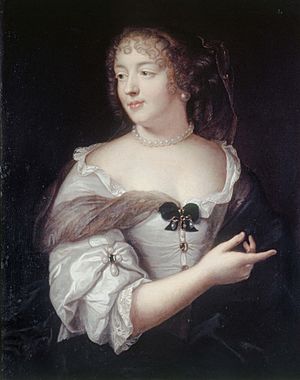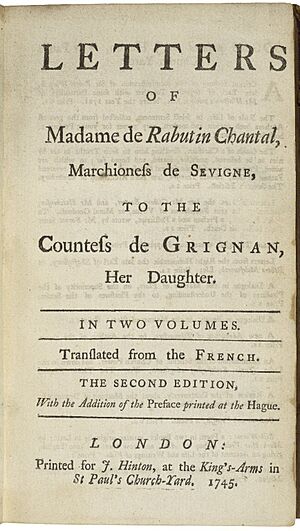Marie de Rabutin-Chantal, marquise de Sévigné facts for kids
Quick facts for kids
Madame
Marie de Raubtin-Chantal
|
|
|---|---|
| Marquise de Sévigné | |

Marquise de Sévigné by Claude Lefèbvre (1665)
|
|
| Known for | French Baroque woman of letters |
| Born | 5 February 1626 Paris, Kingdom of France |
| Died | 17 April 1696 (aged 70) Grignan, Kingdom of France |
| Noble family | de Chantal |
| Spouse(s) | Henri de Sévigné, Marquis de Sévigné |
| Issue | Françoise-Marguerite de Sévigné Charles de Sévigné |
| Father | Celse Bénigne de Raubtin |
| Mother | Marie de Coulanges |
Marie de Rabutin-Chantal, also known as Madame de Sévigné, was a famous French writer. She lived from 1626 to 1696. She is best known for the many letters she wrote. These letters were full of cleverness and lively descriptions. Most of them were sent to her daughter, Françoise-Marguerite de Sévigné. Today, she is seen as one of the most important French writers of the 1600s.
Contents
Life of Madame de Sévigné
Marie de Rabutin-Chantal was born in Paris, France, on February 5, 1626. Her family was old and well-known in Burgundy. Her father, Celse Bénigne de Rabutin, was killed in a battle in 1627. Her mother died a few years later. This made Marie an orphan at just seven years old.
Early Life and Education
After her parents died, Marie was cared for by her grandparents. When her grandfather passed away in 1636, her uncle, Christophe de Coulanges, became her guardian. He was an abbé, which is a type of priest. He made sure Marie received a very good education. She often called him "le Bien Bon," meaning "the very good one," in her letters.
Marriage and Family
In 1644, Marie de Rabutin-Chantal married Henri, marquis de Sévigné. He was a nobleman from Brittany. They moved to his family home, Les Rochers, near Vitré. This place later became famous because of her writings.
Marie and Henri had two children. Their daughter, Françoise, was born in 1646. Their son, Charles, was born in 1648.
Henri de Sévigné was not good with money. He spent it very quickly. However, Marie's uncle helped her keep much of her own money safe. In 1651, Henri was badly hurt in a duel and died two days later. Marie was only 24 years old when her husband died. She never married again. Instead, she focused on raising her children.
Life in Paris and Letter Writing
After her husband's death, Madame de Sévigné spent time at Les Rochers. But she soon returned to Paris. She often went to special gatherings called salons. These were places where important people met to talk about ideas and art. She was a regular at the salon of Nicolas Fouquet, who worked for King Louis XIV.
Madame de Sévigné was very close to her daughter, Françoise. In 1669, Françoise married François Adhémar de Monteil, comte de Grignan. He was appointed as a governor in Provence, so they had to move there. This meant they lived far from each other.
Because they were separated, Madame de Sévigné began writing many letters to her daughter. The first of these famous letters was sent on February 6, 1671. Their letters continued until Madame de Sévigné's death.
By 1673, people started copying and sharing Madame de Sévigné's letters. This meant she knew her letters were being read by many people. She wrote them carefully, knowing they were almost like public documents.
Later Years and Final Days
In 1676, Madame de Sévigné became very ill. She recovered after visiting Vichy, a famous spa town. Her letters describing life at this spa are some of her best. She also wrote about the trial of Madame de Brinvilliers, a famous event at the time.
In 1684, her son Charles got married. Madame de Sévigné divided her money among her children. She kept only a small part for herself.
She continued to attend important events and write about them. In 1688, she saw a play called Esther by Jean Racine at the Saint-Cyr school. Her letters from this time give fun descriptions of court life.
Madame de Sévigné lost several close friends in her later years. Her cousin Roger de Bussy-Rabutin died in 1693. Her friend Madame de La Fayette, another great writer, also died that year.
In 1696, while visiting her daughter, Madame de Sévigné caught a fever. She died on April 17, 1696, in Grignan, and was buried there.
Madame de Sévigné's Works
Madame de Sévigné wrote letters to her daughter for almost 30 years. At first, some of her letters were published secretly in 1725. Later, her granddaughter, Pauline de Simiane, decided to publish them officially.
Working with an editor, she published 614 letters between 1734 and 1737. Then, 772 letters were published in 1754. Her granddaughter chose which letters to publish. She left out letters that were too personal or seemed not well-written. Some of the letters were even changed to fit the writing style of the time. This makes people wonder how true to the originals some of the published letters are.
We know of 1,120 letters written by Madame de Sévigné. Only about 15% of them are signed. The others were often destroyed after they were read. However, in 1873, old copies of her letters were found. These copies were based directly on Madame de Sévigné's original writings. They included about half of the letters she sent to her daughter.
Madame de Sévigné's letters have also appeared in other famous books. They are mentioned in In Search of Lost Time by Marcel Proust. They were the favorite reading of the narrator's grandmother in that novel. She also inspired a character in The Bridge of San Luis Rey by Thornton Wilder.
Portrayals in Film and Television
Madame de Sévigné's life has been shown in several films and TV shows:
- Si Versailles m'était conté (1954), where she was played by Jeanne Boitel.
- Madame de Sévigné (TV), where she was played by Claude Jade.
- D'Artagnan amoureux (1977), a TV series.
- Madame de Sévigné: Idylle familiale (1979).
- Madame de Sévigné à Grignan (2000), a documentary.
- Sévigné (2005), a feature film.
- Le Roi, l'Écureuil et la Couleuvre (2010, TV).
See also
 In Spanish: Madame de Sévigné para niños
In Spanish: Madame de Sévigné para niños


